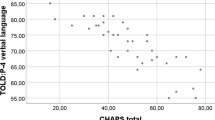Abstract
Introduction
Use of cochlear implants has been a turning point in the life of the hearing-impaired children enabling them to participate in the world of sounds. Research shows that even after cochlear implantation auditory training is necessary as it facilitates the development of verbal skills. A number of kits for auditory training are available in the West. The author had an exposure to a number of auditory training kits in the US, as a part of her Fulbright Research Fellowship. In our country, there is a dearth of such material for auditory training. Besides this, India being a multilingual country, it becomes difficult if not impossible to develop language specific auditory programs. Hence, the need for the project proposal which was to develop material in Hindi and Marathi in the form of kit and CD-ROMs for the various levels of auditory training.
Methodology
With the help of latest scientific techniques, material in the form of worksheets, audiocassettes and CD-ROMs were developed and field tested for all four levels of auditory training. Children with hearing impairment using hearing aids and cochlear implants were given auditory training using the developed material.
Results
t-test which was carried revealed that there is a significant difference between pre and post training performance of children.
Conclusions
A systematic approach in the form of a kit comprising of audio cassettes and CD-ROMs is now available in Hindi and Marathi for use at home for professionals and parents of children with hearing impairment.
Similar content being viewed by others
References
Glazzard, P (1982) Learning Activities and Teaching Ideas for the Special Child in the Regular Classroom. New Jersey: Prentice Hall Inc.
Hamaguchi, PM (1995) Childhood Speech, Language and Listening Problems—What Every Parent Should Know. New York: John Wiley & Sons
Oyer HJ, Crowe B, Haas WH (1987) Speech, Language and Hearing Disorders—A Guide for the Teacher. Boston: College Hill
Whitehurst M (1978) Auditory Training for Children. Washington D.C: Alexander Graham Bell Association for the Deaf Inc.
Tracy J (1968) Getting Your Baby Ready to Talk. Children’s Bureau Welfare Administration, US Department of Health
Northcott WH (1983) I Heard That! A Developmental Sequence of Listening Activities, A.G.Bell Association for the Deaf Inc.: Washington DC
Author information
Authors and Affiliations
Corresponding author
Rights and permissions
About this article
Cite this article
Kant, A., Adhyaru, M. Home auditory training program (HAP) for cochlear implantees and hearing impaired children using hearing aids—an outcome of a three-year research project. Indian J Otolaryngol Head Neck Surg 61, 54–58 (2009). https://doi.org/10.1007/s12070-009-0035-3
Published:
Issue Date:
DOI: https://doi.org/10.1007/s12070-009-0035-3




